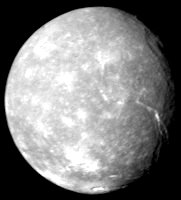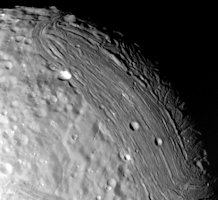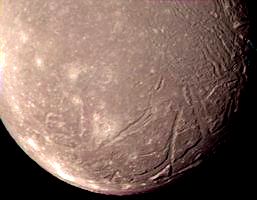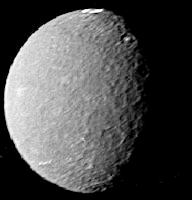27 Moons
Table of Contents
At last count, Uranus has at least 27 moons. This is quite impressive when we consider that the Earth has, of course, only one moon and when we consider that Uranus’s largest moon (Titania) is only half the size that the Earth’s moon is. That means that there are more than a couple of dozen moon-lets orbiting around Uranus; it seems a wonder that they don’t crash into one another at some point in their orbits. One of the ‘discovered’ moons of Uranus has not yet been given official status as a moon because astronomers cannot agree on whether or not it is actually a moon. Either way, the amount of moons is high.
Many moons ago Uranus itself had not even been discovered; never mind all of the moons orbiting around it. The moons are still popping up! The Solar System seems to be losing planets, but the planets that still have their status as planets are gaining moons like there’s no tomorrow. Of course, planets like the Earth are not going to acquire new moons, but the planets that are farther away still have new discoveries waiting for us here on Earth. For example, it was recently decided that Pluto is not actually a planet – too bad for everyone whose favorite planet was Pluto. Likewise, just when you thought you had Uranus’ moons memorized, a few more pop up.
All of its moons compositions are generally rock and ice. Uranus’s moons are generally categorized as the Inner Moons (13), Major Moons (5) and Irregular Moons (9). The Inner Moons are named Cordelia, Ophelia, Bianca, Cressida, Desdemona, Juliet, Portia, Rosalind, Cupid, Belinda, Perdita, Puck, and Mab. The Major Moons are named Miranda, Ariel, Umbriel, Titania, and Oberon. The Irregular Moons are named Francisco, Caliban, Stephano, Trinculo, Sycorax, Margaret, Prospero, Setebos, and Ferdinand. Some of these names may look familiar to you, a matter of fact, all of Uranus’s moons are named after characters from Alexander Pope and William Shakespeare’s works.

Titania
Uranus’s largest moon is Titania with a diameter of 1,577.8 km or 980 miles and a mass of 3.42 x 1021 kg. This makes it the eighth largest moon in our solar system (less than half the size of Earth’s moon). Titania was discovered on January 11, 1787, by William Herschel. Its distance from Uranus is 436,300 km or 271,104 miles and takes 8.7 Earth days to make 1 complete orbit around Uranus. Titania’s orbit around Uranus is almost a perfect circle with the orbit eccentricity at 0.0011 and is closest (Periapsis) to the planet at 435,820 km or 270,805 miles and farthest (Apoapsis) from the planet at 436,780 km or 271,402 miles. The orbit inclination is only 0.079°, which means it’s North pole is getting about 42 years of straight sunlight and about 42 years of straight darkness. You’ll remember that Uranus is on its side so when the moons orbit the planet they are actually moving in a vertical manner compared to the horizontal manner we are accustomed to here on Earth. The density of Titania is 1.662 g/cm3, which is less than half the density of Earth’s moon.

Miranda
Another moon of Uranus that is interesting is Miranda. It was discovered on February 16, 1948, by Gerard P. Kuiper. Its distance from Uranus is 129,900 km or 80,716 miles and takes 1.413 Earth days to make 1 complete orbit around the planet. Miranda’s average diameter is 471.6 km or 293 miles with a mass of 6.5941 x 1019 kg. Sounds boring so far, what’s so interesting about it? Well if you like the Grand Canyon, then you’ll definitely like Miranda. This moon’s fault canyons can be more than 10 times as deep as the Grand Canyon. Scientists are not sure why such a rigid surface exists on Miranda, where some believe it may be from other objects crashing into it which would raise the partially melted ice to the surface causing this rigid formation. Building on this possible theory since about 42 years are in straight sunlight for each pole the Sun may play some role in helping the ice melt when foreign objects crash into it.

Ariel
What’s Uranus’s brightest moon? That would be Ariel, which was discovered on October 24, 1851, by William Lassell. Its distance from Uranus is 190,900 km or 118,620 miles and takes 2.52 Earth days to make 1 complete orbit around the planet. Ariel’s average diameter is 1,157.8 km or 719.4 miles with a mass of 1.2948 x 1021 kg. Its composition is believed to be about 50% ice and 50% rock. Ariel’s other notable feature is its long canyons which run across its surface. The reason for these unique canyons is unknown. Some scientists rule out it being from water because at these temperatures it is very difficult for water to form. However one must also think that if a large asteroid came colliding with Ariel, enough heat could be produced from the collision which would temporarily melt the ice.

Umbriel
Ever wonder what a fluorescent cheerio would look like on a moon. Then look at Uranus’s moon Umbriel which has a bright ring spot on it. One of the theories behind this distinctive feature is it was impacted by some large object which caused the inner material (which is brighter than the surface) of the moon to surface. But that is still a mystery why it has that bright ring. Umbriel was discovered in the year 1851 by William Lassell. Its distance from Uranus is 266,000 km or 165,285 miles and takes 4.144 Earth days to make 1 complete orbit around the planet. Umbriel’s average diameter is 1,169.4 km or 727 miles with a mass of 1.2214 x 1023 kg.
List of Uranus Moons
| Moon | Date Discovered | Distance from Uranus (km) | Comparison Distance to Earth and its Moon | Orbit Period (Earth Days) | Mean Diameter (km) | Comparison to Earth’s Moon Diameter | Mass (kg) | Surface Gravity (m/s2) | Comparison to Earth’s Moon Gravity |
|---|---|---|---|---|---|---|---|---|---|
| Ariel | October 24, 1851 | 190900 | 0.50 | 2.52 | 1157.8 | 0.33 | 1.2948 x 1021 | 0.258 | 0.159 |
| Belinda | January 13, 1986 | 75300 | 0.20 | 0.624 | 80.6 | 0.02 | 3.5668 x 1017 | 0.015 | 0.009 |
| Bianca | January 23, 1986 | 59200 | 0.15 | ? | 51.4 | 0.01 | 9.2917 x 1016 | 0.009 | 0.006 |
| Caliban | September 6, 1997 | 7231100 | 18.81 | 579.73 | 72.0 | 0.02 | 2.9973 x 1017 | 0.015 | 0.009 |
| Cordelia | January 20, 1986 | 49800 | 0.13 | 0.335 | 40.2 | 0.01 | 4.4960 x 1016 | 0.007 | 0.004 |
| Cressida | January 9, 1986 | 61800 | 0.16 | 0.464 | 79.6 | 0.02 | 3.4320 x 1017 | 0.014 | 0.009 |
| Cupid | August 25, 2003 | 74392 | 0.19 | 0.613 | 36.0 | 0.01 | ? | ? | ? |
| Desdemona | January 13, 1986 | 62700 | 0.16 | 0.474 | 64.0 | 0.02 | 1.7834 x 1017 | 0.012 | 0.007 |
| Ferdinand | August 13, 2001 | 20430000 | 53.15 | 2970.03 | 20.0 | 0.01 | 6.2944 x 1015 | 0.004 | 0.002 |
| Francisco | August 13, 2001 | 4282900 | 11.14 | 267.09 | 22.0 | 0.01 | 8.3925 x 1015 | 0.005 | 0.003 |
| Juliet | January 3, 1986 | 64400 | 0.17 | 0.493 | 93.6 | 0.03 | 5.5750 x 1017 | 0.017 | 0.010 |
| Mab | August 25, 2003 | 97736 | 0.25 | 0.923 | 48.0 | 0.01 | ? | ? | ? |
| Margaret | August 29, 2003 | 14146700 | 36.80 | 1661 | 20.0 | 0.01 | 6.2944 x 1015 | 0.004 | 0.002 |
| Miranda | February 16, 1948 | 129900 | 0.34 | 1.413 | 471.6 | 0.14 | 6.5941 x 1015 | 0.079 | 0.049 |
| Oberon | November 21, 1904 | 583500 | 1.52 | 13.46 | 1522.8 | 0.44 | 2.8834 x 1021 | 0.332 | 0.204 |
| Ophelia | June 8, 1905 | 53800 | 0.14 | 0.376 | 42.8 | 0.01 | 5.3952 x 1016 | 0.008 | 0.005 |
| Perdita | May 18, 1999 | 76417 | 0.20 | 0.638 | 30.0 | 0.01 | ? | ? | ? |
| Portia | June 8, 1905 | 66100 | 0.17 | 0.513 | 135.2 | 0.04 | 1.6815 x 1018 | 0.025 | 0.015 |
| Prospero | July 18, 1999 | 16276800 | 42.34 | 1978.37 | 50.0 | 0.01 | 9.8912 x 1016 | 0.011 | 0.007 |
| Puck | June 8, 1905 | 86000 | 0.22 | 0.762 | 162.0 | 0.05 | 2.8939 x 1018 | 0.029 | 0.018 |
| Rosalind | June 8, 1905 | 69900 | 0.18 | 0.558 | 72.0 | 0.02 | 2.5477 x 1017 | 0.013 | 0.008 |
| Setebos | July 18, 1999 | 17420400 | 45.32 | 2225.08 | 48.0 | 0.01 | 8.6923 x 1016 | 0.010 | 0.006 |
| Stephano | July 18, 1999 | 8007400 | 20.83 | 677.47 | 32.0 | 0.01 | 2.5477 x 1016 | 0.007 | 0.004 |
| Sycorax | September 6, 1997 | 12179400 | 31.68 | 1288.38 | 150.0 | 0.04 | 2.6976 x 1018 | 0.032 | 0.020 |
| Titania | November 21, 1904 | 436300 | 1.14 | 8.706 | 1577.8 | 0.45 | 3.4200 x 1021 | 0.367 | 0.226 |
| Trinculo | August 13, 2001 | 8505200 | 22.13 | 749.4 | 18.0 | 0.01 | 4.6459 x 1015 | 0.004 | 0.002 |
| Umbriel | January 24, 1905 | 266000 | 0.69 | 4.144 | 1169.4 | 0.34 | 1.2214 x 1021 | 0.238 | 0.146 |
Although Uranus’ moons may be smaller than the Earth’s moon and much smaller than the Earth itself, some of its moons exhibit truly mysterious and fascinating phenomena. For example, Miranda has a cliff face of 12 miles (more than twice the height of Mount Everest). This is impressive on its own, but when it’s considered in light of the relative size of Miranda compared to the Earth – the size of this cliff face is just beyond belief. Miranda is one of Uranus’ small moons. Astronomers have figured out that if this cliff face on the surface of Miranda were scaled (if Miranda were scaled up to the size of the Earth) the cliff face (12 miles) would reach all the way into, from the Earth’s surface, the area where spacecraft orbit the Earth.
The story of Uranus’ moons is not a simple one, not in number and not in features. In addition, when you consider what little is actually known about the moons at present due to the sheer distance from here to there, it is obvious that there are many more astounding surprises just waiting to be uncovered.
Image Credits: Courtesy NASA/JPL-Caltech.
